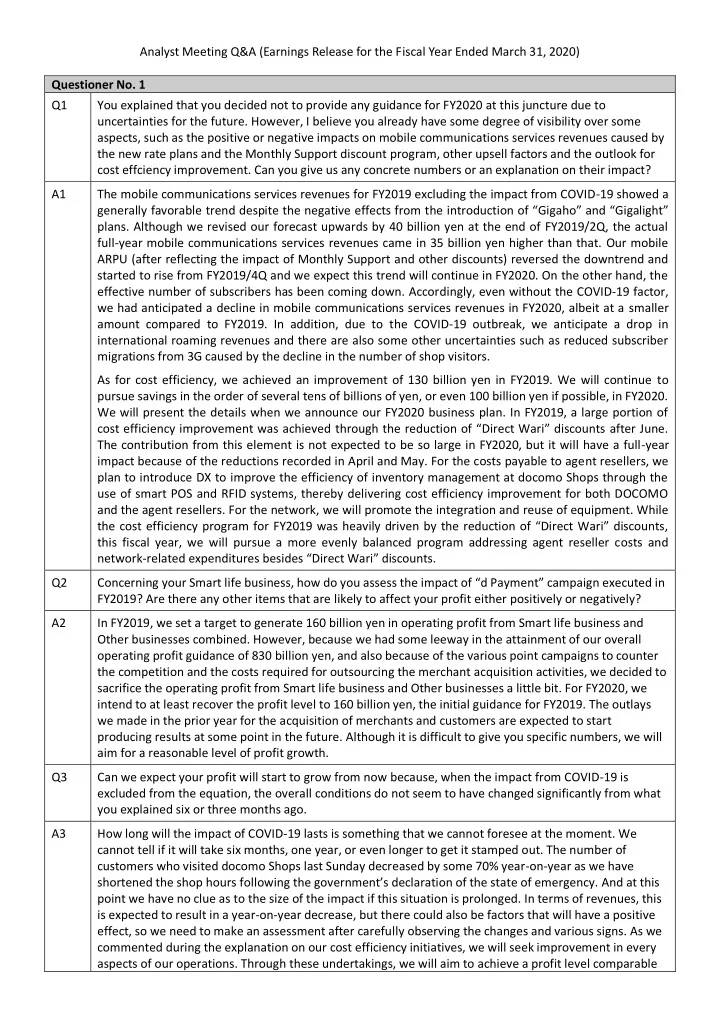

Analyst Meeting Q&A (Earnings Release for the Fiscal Year Ended March 31, 2020) Questioner No. 1 Q1 You explained that you decided not to provide any guidance for FY2020 at this juncture due to uncertainties for the future. However, I believe you already have some degree of visibility over some aspects, such as the positive or negative impacts on mobile communications services revenues caused by the new rate plans and the Monthly Support discount program, other upsell factors and the outlook for cost effciency improvement. Can you give us any concrete numbers or an explanation on their impact? A1 The mobile communications services revenues for FY2019 excluding the impact from COVID-19 showed a generally favorable trend despite the negative effects from t he introduction of “Gigaho” and “Gigalight” plans. Although we revised our forecast upwards by 40 billion yen at the end of FY2019/2Q, the actual full-year mobile communications services revenues came in 35 billion yen higher than that. Our mobile ARPU (after reflecting the impact of Monthly Support and other discounts) reversed the downtrend and started to rise from FY2019/4Q and we expect this trend will continue in FY2020. On the other hand, the effective number of subscribers has been coming down. Accordingly, even without the COVID-19 factor, we had anticipated a decline in mobile communications services revenues in FY2020, albeit at a smaller amount compared to FY2019. In addition, due to the COVID-19 outbreak, we anticipate a drop in international roaming revenues and there are also some other uncertainties such as reduced subscriber migrations from 3G caused by the decline in the number of shop visitors. As for cost efficiency, we achieved an improvement of 130 billion yen in FY2019. We will continue to pursue savings in the order of several tens of billions of yen, or even 100 billion yen if possible, in FY2020. We will present the details when we announce our FY2020 business plan. In FY2019, a large portion of cost efficiency improvement was achieved through the reduction of “Direct Wari” discounts after June. The contribution from this element is not expected to be so large in FY2020, but it will have a full-year impact because of the reductions recorded in April and May. For the costs payable to agent resellers, we plan to introduce DX to improve the efficiency of inventory management at docomo Shops through the use of smart POS and RFID systems, thereby delivering cost efficiency improvement for both DOCOMO and the agent resellers. For the network, we will promote the integration and reuse of equipment. While the cost efficiency program for FY2019 was heavily driven by the reduction of “Direct Wari” discounts, this fiscal year, we will pursue a more evenly balanced program addressing agent reseller costs and network-related expenditures besides “Direct Wari” discounts . Q2 Concerning your Smart life business, how do you assess the impact of “d Payment” campaign executed in FY2019? Are there any other items that are likely to affect your profit either positively or negatively? A2 In FY2019, we set a target to generate 160 billion yen in operating profit from Smart life business and Other businesses combined. However, because we had some leeway in the attainment of our overall operating profit guidance of 830 billion yen, and also because of the various point campaigns to counter the competition and the costs required for outsourcing the merchant acquisition activities, we decided to sacrifice the operating profit from Smart life business and Other businesses a little bit. For FY2020, we intend to at least recover the profit level to 160 billion yen, the initial guidance for FY2019. The outlays we made in the prior year for the acquisition of merchants and customers are expected to start producing results at some point in the future. Although it is difficult to give you specific numbers, we will aim for a reasonable level of profit growth. Q3 Can we expect your profit will start to grow from now because, when the impact from COVID-19 is excluded from the equation, the overall conditions do not seem to have changed significantly from what you explained six or three months ago. A3 How long will the impact of COVID-19 lasts is something that we cannot foresee at the moment. We cannot tell if it will take six months, one year, or even longer to get it stamped out. The number of customers who visited docomo Shops last Sunday decreased by some 70% year-on-year as we have shortened the shop hours following the government’s declaration of the state of emergency. And at this point we have no clue as to the size of the impact if this situation is prolonged. In terms of revenues, this is expected to result in a year-on-year decrease, but there could also be factors that will have a positive effect, so we need to make an assessment after carefully observing the changes and various signs. As we commented during the explanation on our cost efficiency initiatives, we will seek improvement in every aspects of our operations. Through these undertakings, we will aim to achieve a profit level comparable
Recommend
More recommend